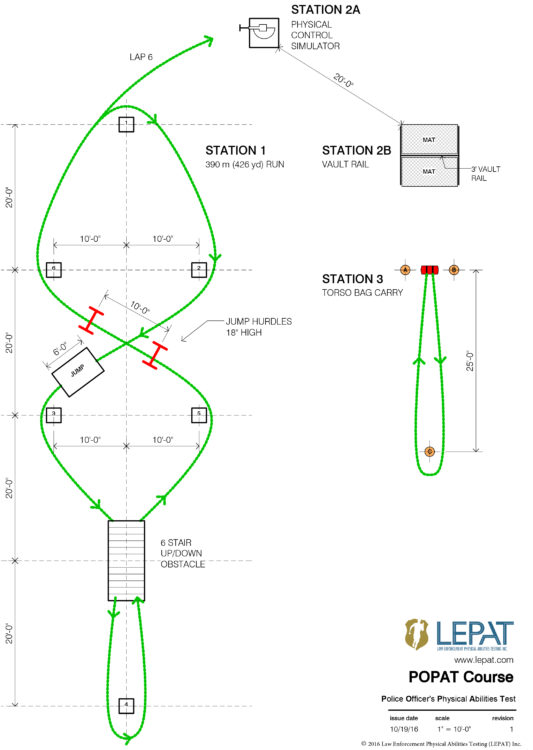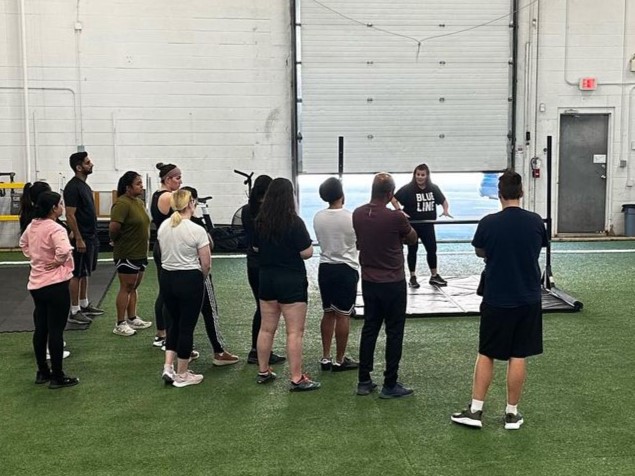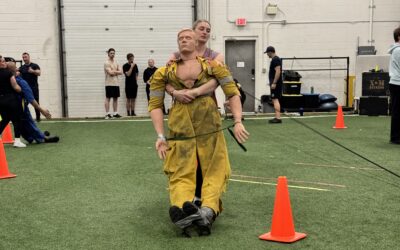
Understanding the POPAT Fitness Test
The Police Officers Physical Abilities Test (POPAT) is one of the most challenging law enforcement fitness assessments in Canada. It’s designed to simulate the real-life physical demands of police work — sprinting after a suspect, climbing over obstacles, controlling resistance, and carrying weight — all under time pressure.
Agencies in British Columbia and Saskatchewan use the POPAT to assess whether a candidate can handle the physical intensity of basic training and real-world policing. It’s not just about fitness — it’s about function, control, and endurance under fatigue.
At Blue Line Fitness Testing, we regularly coach and test applicants for POPAT success. Our goal? To help you understand what’s expected and prepare with confidence.
What’s Involved in the POPAT
The first section of POPAT consists of:
- Section 1- An obstacle run which the participant negotiates six times. The course includes a 6-ft mat jump (*note some agencies in BC have now reduced this to a 5-ft mat jump). The participant must clear the jump or they go back to the second maker and attempt the jump again. If they cannot clear the jump on the second attempt, they get one more attempt to jump and then the test is ended.
- Stairs – 6 stairs up and 6 stairs down. The participant must run up and down the stairs on each lap, touching at least one stair on the way up, the top platform and one stair on the way down. The participant then proceeds towards the next marker and runs back to the stairs going up and down again.
- 2 – 18-in hurdles. The participant must jump over two 18-inch hurdles on each lap. Participants who knock down hurdles must pick them up and place them back where they belong and then must re-do the hurdle.
- The participant must complete six laps before starting the next section.
- Section 2 – A push/pull machine that mimics physical control of a resistant individual (80 lb resistance). Upon finishing the obstacle run, the participant moves immediately to the push/pull station, which consists of a specific push/pull unit set at 80lbs. The participant must perform the pull activity first. You must complete six 180 degree arcs of both the push and pull. If the weight drops, you must start back at arc 1. You cannot lock your elbows, you must have a slight bend in them and you cannot cross your feet as you move through the arcs. You will be given 1 warning and asked to correct it and then will have to re-do all six arcs.
- Pull Activity: The participant grasps the rope and pulls so the weight plates lift off the base of the machine and then moves right or left. Six arcs are completed without allowing the weight to touch the base.
- Push Activity: The participant then immediately pushes the weight off the base and begins the activity of 6 arcs. The arms must be bent at the elbows throughout the performance of the activity with the chest off the handle. Six arcs must be completed.
- Section 3 – This station involves modified Squat-Thrust-and-Stand (STAS) activity followed by jumping over a 3′ (.91 m) vault rail. From the Pull-Push Station, the participant moves to the vault and begins with the chest, hips and chin touching the mat. The participant then stands and vaults over the rail, touching the rail with only the hands. Landing on the feet, the participant then does a reverse STAS (to end up on your back) so that the shoulder blades, buttocks and heels touch the mat. The participant then does a complete sit up, stands and vaults over the rail and repeats the activity until a total of 10 Squat-Thrust-and-Stands (5 to the front, 5 to the back) and 9 Vaults are completed. Once the participant finishes the last STAS and stands up in a balanced position, the time is stopped. This ends the timed portion of the test. Should any error be made during the vault station, the specific activity must be repeated until it is performed correctly. Placing hands on the rail to pull yourself up or help yourself down to the mat is an error. Placing the foot on the rail is an error. Failing to touch the chest or the shoulder blades on the mat is an error.
- Section 4 – NOT TIMED- A weighted bag carry (100 lb), representing the drag or carry of a person or heavy object to safety.
Depending on your agency, the passing time can vary — usually between 4:15 and 4:45 minutes.

Why the POPAT is So Demanding
The POPAT isn’t just a cardio test. It’s a total-body assessment that challenges speed, strength, agility, coordination, and recovery — all at once. The transitions between tasks make it even more demanding because your heart rate stays elevated the entire time.
Many first-time candidates massively underestimate how quickly fatigue builds up and how much energy and effort you will need to last the full course, make it through the push-pull and then still do the 3 foot vault. That’s where specific conditioning comes in — knowing what energy systems you’re training and how to pace each section can make the difference between a pass and a re-test. This test is much harder than the PARE or COPAT and combines both of the hardest parts of these tests while adding weight to both the Push/Pull and the weighted bag and making the jump longer.
How to Train for the POPAT
The best training plan for the POPAT includes a mix of strength, conditioning, and skill-based practice that is started WELL BEFORE your application is even submitted to the law enforcement agency of your choice.
1. Build Your Base Fitness
A solid foundation of strong cardiovascular endurance and muscular strength is essential. We recommend:
- Running, hill, assault bike or rowing intervals (min 1-2min) for speed and recovery.
- Functional lifts like squats, deadlifts, and push presses to strengthen the legs and core.
- Circuit-style workouts combining movements like burpees, step-ups, and sled pushes to mimic the intensity of the course.
Participants should be working out at least 5-6 days a week at a high intensity before attempting the POPAT. Walking, jogging, and work based exercises like heavy lifting of boxes or equipment don’t cut it! Neither does recreational sports like rec hockey or slo-pitch. You MUST be going hard in the gym regularly (without 10 min breaks in between sets to look at IG on your phone!) to come close to passing this fitness test.
2. Simulate the POPAT
Practice tests are your best preparation. At Blue Line, we run full POPAT practice tests so you can practice the entire test including transitions, timing, and pacing in a realistic setting. This helps you learn when to push, when to recover, and how to efficiently move through each station. When you attend a Blue Line Fitness Testing practice test, we will spend time with you (as much as you need), walking you through the course, teaching you tips and techniques to maximize efficiency, avoid penalties, and get the best time possible. We also break down every component into time intervals and provide a written evaluation to identify what areas you might be struggling in, so that you will know where to focus your training!
When you sign up to run a practice test, you will practice your test to the exact standards prescribed by the official protocols. Our practice tests run alongside our Official tests, so you will also get to observe multiple people running the official test and see exactly what the test entails before you run your practice. Practice tests cost $100 and we do not require a medical clearance from a doctor to run with us.
3. Master the Push-Pull
Many applicants struggle with the push-pull machine. At Blue Line we offer weekly Open Gym classes where you can spend as much time as you need practicing the push-pull machine. If you do not live in Edmonton, focus your own workouts on:
- Core stability and rotation using exercises like landmine twists and Pallof presses.
- Upper body strength through push-ups, pull-ups, and rows.
- Footwork and positioning — your stance and grip can make a major difference in efficiency.
Technique is KEY for the push-pull machine regardless of which law enforcement fitness test you are running! If you technique is garbage, it doesn’t matter if you can bench press 300lbs, you will fail this obstacle. When you are gassed after the obstacle course, you will need every ounce of techique to help keep the machine up.
4. Train For the 5/6 fOOT jUMP & the Bag Carry
The JUMP section of the POPAT is a killer and where a lot of people fail. 6 feet to jump is far and if your legs feel like cement while running, it’s even harder! Training plyometrics to help with your jump will ensure you can easily clear it and be able to focus on speed during your laps. The final bag carry also requires raw power and grit.
Incorporate:
- Farmer’s carries for grip and shoulder endurance.
- Deadlifts and sandbag drags for posterior chain strength.
- High-intensity finishers that challenge you when tired — this is what test day feels like.
Common POPAT Mistakes to Avoid
Not starting your training early enough: DO NOT underestimate how challenging this test is and how long it will actually take you to train for it to pass!! Most people take 6-8 months to properly train and pass the POPAT with a competitive time.
Underestimating recovery: Don’t ignore rest and mobility. Fatigue leads to poor form and slower times.
Skipping technical practice: Knowing how to vault, jump, and transition saves precious seconds.
Focusing only on cardio: You need both strength and conditioning to perform efficiently.
Real Success Stories from Blue Line Clients
“They have great instructors that show how to run the courses and even give you a few tricks to lower your time. Thay are more than happy to answer any questions you may have before you run the course”
Imanuel B
Many of our clients come in nervous — unsure if they’ll ever reach the required time. After 4–6 weeks of targeted training and a few practice runs, they’re not just passing — they’re beating the clock with confidence.
The secret isn’t about being the fittest person in the room — it’s about training with the proper equipment, being guided by experienced trainers that are well versed in law enforcement fitness tests, and YOUR dedication!
Final Thoughts: The POPAT is Just the Beginning
Passing the POPAT is a major accomplishment, but it’s also just step one in your law enforcement fitness journey. Basic training and on-duty life will challenge your body and mind in new ways. That’s why maintaining your fitness long-term is essential — it keeps you safe, resilient, and capable of handling the demands of the job.
Ready to train and PASS your POPAT?
Join us at Blue Line Fitness Testing in Edmonton for practice tests, personalized coaching, and structured training plans designed for law enforcement applicants and then run your OFFICIAL test with us to submit to your required agency!
👉 Book your next POPAT prep session today: www.bluelinefitnesstesting.com
Additional Resources:
- How to Train for Law Enforcement Fitness Tests Read here.
- Fitness Training for Tactical Situations: What You Need to Know Read here.
- Benefits of Mock Fitness Testing Before the Big Day Read here.







